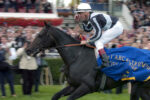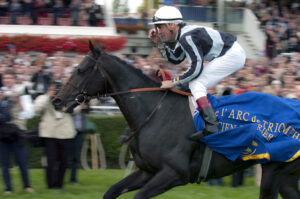The racing world took a collective sharp intake of breath when it was announced that a number of the highly prized Niarchos broodmare band would come under the hammer at the Goffs November Sale. Under the direction of Stavros Niarchos and latterly his daughter Maria Niarchos-Gouaze, the Niarchos silks have been part of racing’s fabric in Europe and North America for the best part of six decades, accumulating 67 Group or Grade 1 winners along the way. A Niarchos family is instantly recognisable, often stretching back over multiple generations, and invariably complemented in parts by a Niarchos-bred stallion, some of them breed-shapers such as Nureyev, Kingmambo or Machiavellian.
But before anyone tries to consign this powerful operation to the history books, it must be stressed that the draft heading to Goffs is merely reflective of a restructuring and that when all is done and dusted, around 120-head will remain in the fold including the exciting older horses Piz Badile and Passenger as well as multiple Group 1 producer Alpha Lupi.
“A core group of horses will remain and the bloodlines will be very much ongoing”
“The family have decided to have a restructuring of the broodmares and fillies, and the sale at Goffs is the first stage and a major part of that,” says Alan Cooper, racing manager to the Niarchos family. “After Goffs, there are a couple catalogued at Tattersalls and then seven fillies and one mare going to the Arqana December Sale.
“It’s very much a restructuring and of course, it will look different going forward. But a core group of horses will remain and the bloodlines will be very much ongoing.”
A group of 30 Niarchos horses went through last year’s Goffs November Sale, among them Group 2 winner Bocca Baciata, who commanded €530,000 in foal to Mehmas, and Albula, a Group 3-placed Galileo daughter of high-class Australian performer Dawn Wall who sold for €500,000. Both headed the way of the BBA Ireland on behalf of Zhang Yuesheng’s Lucky Vega Syndicate.
“We had a partial reduction last year at Goffs and this is a follow on,” says Cooper. “Numerically speaking, it’s not much bigger than last year. But there are Group 1 winners in the draft this year, so on racecourse performance it is bigger, and that’s what attracts the attention.”
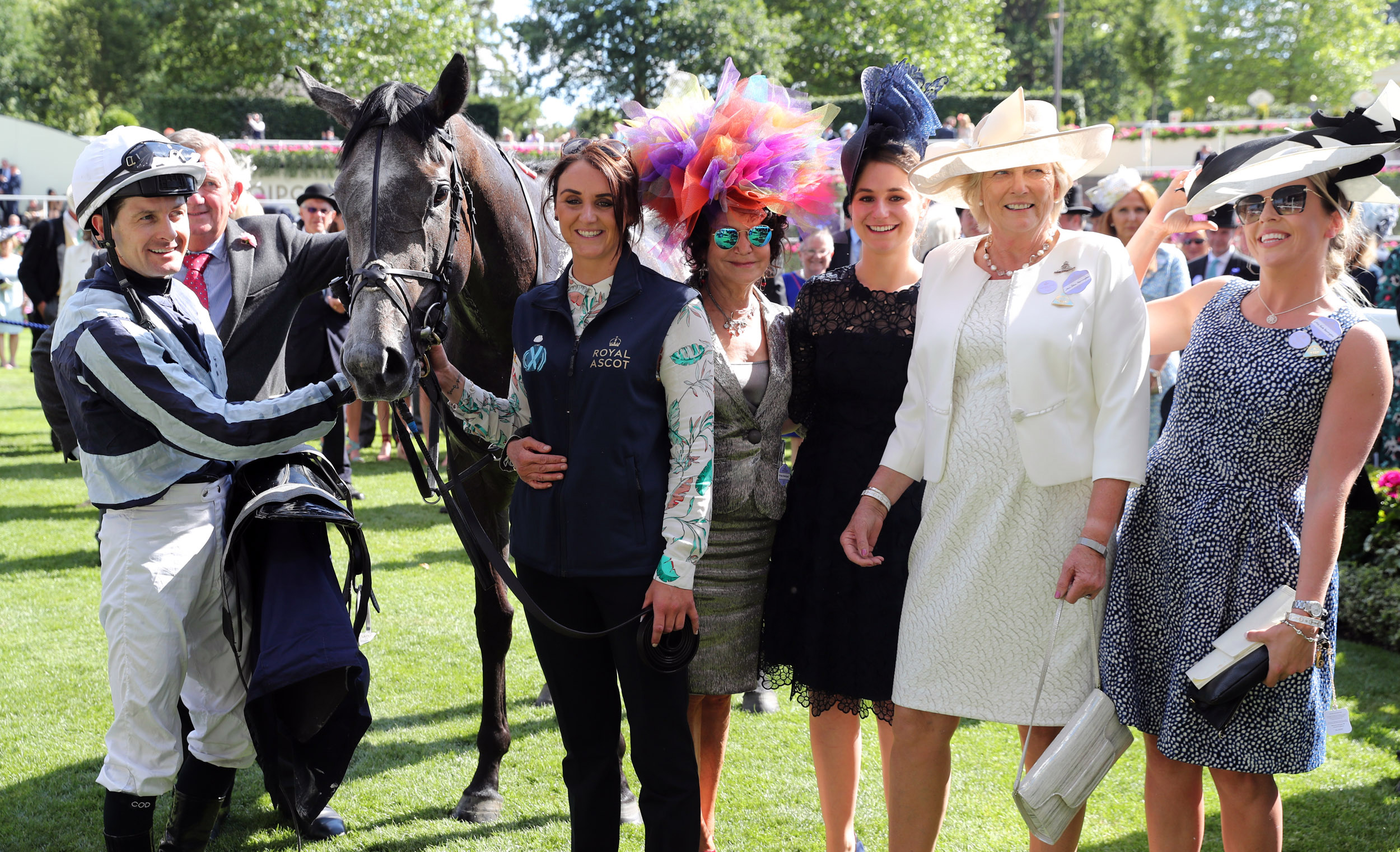
Alpha Centauri pictured with Maria Niarchos and trainer Jessica Harrington following her easy win in the Coronation Stakes at Royal Ascot. Photo – Bill Selwyn
The Group 1 winners that Cooper alludes to are the kind of gems that rarely, if ever, come on to the market.
Alpha Centauri carried all before her for Jessica Harrington in 2018 when rattling off wide-margin victories in the Irish 1,000 Guineas, Coronation Stakes, Falmouth Stakes and the Prix Jacques le Marois, appropriately sponsored by the family’s Haras de Fresnay-le-Buffard. Although best at three, the daughter of Mastercraftsman was also a fast and precocious two-year-old who won a Listed race prior to falling only a neck short of victory in the Albany Stakes at Royal Ascot.
Alpha Centauri is catalogued in foal to Sea The Stars as part of the Niarchos draft from Norelands Stud while her talented half-sister Alpine Star, winner of the 2020 Coronation Stakes, will be offered from Kiltinan Castle Stud in foal to Frankel.
Both these mares would naturally be highly desirable commodities on their racing records alone but the fact is they also belong to one of the most powerful Niarchos dynasties – that of Miesque. Widely regarded as one of the best – if not the greatest – to carry the Niarchos silks, Miesque won ten Group 1 races including the 1,000 Guineas, Poule d’Essai des Pouliches and two renewals of both the Prix Jacques le Marois and Breeders’ Cup Mile. The daughter of Nureyev then proceeded to become just as successful at stud, notably as the dam of Classic winners Kingmambo, later an influential sire, and East Of The Moon. Today, almost 40 stakes winners descend directly from her.
Further opportunities to buy into the Miesque line arise with Flutter, a Galileo daughter of Prix Marcel Boussac winner Rumplestiltskin in foal to Wootton Bassett, while that belonging to Miesque’s dam Pasadoble is represented by Raja Ampat (by Galileo; in foal to Baaeed) and La Fiamma (by War Front; in foal to Mehmas), both of whom descend from the mare via champion miler Six Perfections.
“The Miesque line in particular has become such an influential family through both its stallions and broodmares. It’s phenomenal, really”
Prix Marcel Boussac heroine Albigna, meanwhile, sells as part of the Baroda Stud draft in foal to St Mark’s Basilica.
Proven stakes producer That Which Is Not, whose first foal Piz Badile is due to run in the Breeders’ Cup Turf, is consigned in foal to Frankel by Norelands Stud. She is the latest high-flying member of the Northern Trick dynasty via the Shirley Heights mare Lingerie, whose presence within the draft is bolstered by the stakes-placed Light Of Joy, in foal to Night Of Thunder, and the More Than Ready filly Perseids.
The stakes-placed Malicieuse, in foal to Wootton Bassett, and her daughters Provocateuse, in foal to Kingman, and Bold As Love offer the chance to tap into the powerful Coup De Genie family while that belonging to Hernando’s dam Whakilyric is represented by the Listed-winning, stakes producer Nature Spirits (in foal to New Bay) alongside her daughters Spell On You (in foal to Study Of Man) and Forever Be (in foal to Wootton Bassett).
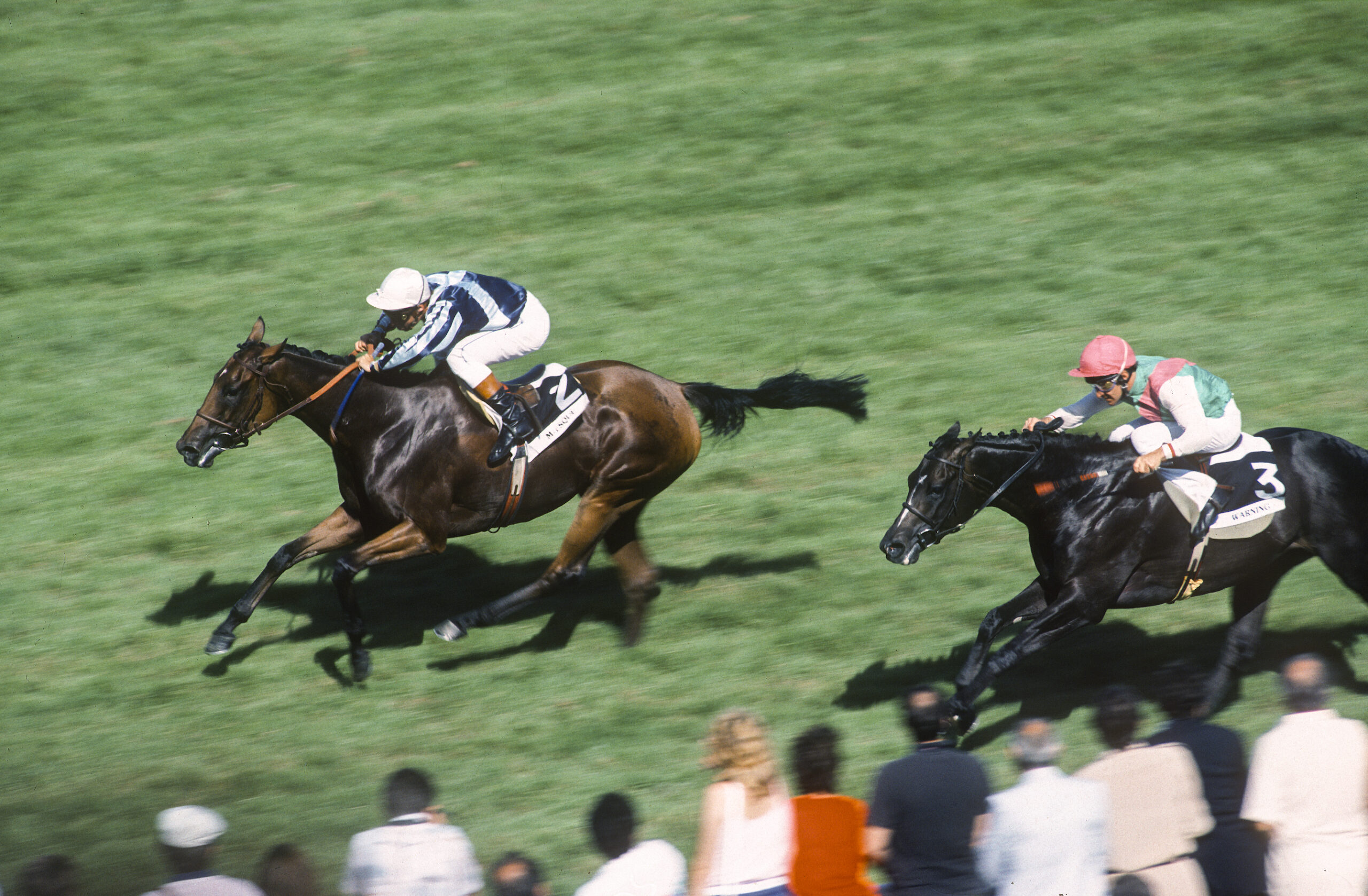
Miesque holds off Warning to win the Prix Jacques le Marois. A number of her descendants are catalogued to the Goffs November Sale. Photo – George Selwyn
Top-class North American performer Martini Glass (in foal to Starspangledbanner), a Grade 1-performing daughter of Miesque’s accomplished sire son Kitalpha, and the Group 3 winners Dawn Wall (in foal to Saxon Warrior), Liquid Amber (in foal to No Nay Never), Mississippi Delta (in foal to Camelot) and Only Mine (in foal to Siyouni) add further lustre to a draft that understandably has the bloodstock world chattering.
“All the major families are represented,” says Cooper. “The Miesque line in particular has become such an influential family through both its stallions and broodmares. It’s phenomenal, really. Miesque was very tough herself and so was her daughter East Of The Moon. She won three Group 1s at three, the Poule d’Essai des Pouliches, Prix de Diane and the Prix Jacques le Marois. She just lasted home in the Prix de Diane, it was a desperate finish and she was very game, and after that she went straight back to a mile. Then you come down to her granddaughters Alpha Centauri, Alpine Star and Discoveries, all Group 1 winners who were tough racemares too. It’s a family with great miling pace.
“We have also have Martini Glass in there. We bought her at the Fasig-Tipton November Sale, one of the attractions being that she’s by Kitalpha, who was out of Miesque. But she was also such a tough racemare herself – she won ten races including the Azeri Stakes and was multiple Grade 1-placed. And we have some nice progeny out of her currently in training with Joseph O’Brien.
“And then you have the Coup De Genie family and Northern Trick line, which comes through That Which Is Not. All these were acquired in the 1980s and are still very much alive.”
Bold ambition
The operation as it is today represents decades of cultivation under the direction of Maria Niarchos, with its foundations based upon the work of Stavros Niarchos and his advisors of the time, in particular trainer Francois Boutin and the BBA’s Sir Philip Payne-Gallwey.
One of the most skilful businessmen of his era, Niarchos built his fortune in the shipping industry, accumulating as many as 80 ships by the mid-1960s. As his business grew during the 1950s, Niarchos dipped his toe into the world of horse racing and there was early success in 1956 when Pipe Of Peace, trained by Sir Gordon Richards, won the Middle Park Stakes and returned the following year to run placed in the 2,000 Guineas and Derby.
There was an early intent of his ambition around the same time when Niarchos made a play for the champion American runner Nashua. In the autumn of 1955, Nashua was at his peak having beaten fellow champion Swaps in a match race, an event that had captured the imagination of the American public. He had gone on to win the Jockey Club Cup but two weeks later was suddenly facing an uncertain future when his owner, William Woodward Jr., was fatally shot. With the estate keen to wind up the bloodstock assets, interested parties were invited to put forward sealed bids for the stock including Nashua, then regarded as the most valuable horse in the world. Niarchos, working with Fasig-Tipton’s Humphrey S. Finney and Brigadier R. S. Scott, then head of the BBA, placed a bid of $900,000 on the horse. It wasn’t enough to match the $1,251,200 put forward by the winning bidder Leslie Combs (Nashua went on become an important sire at Combs’ Spendthrift Farm in Kentucky) but Niarchos did land several of the Woodward mares at Keeneland the following January, including Nashua’s dam Segula at $126,000.
For reasons unknown, Niarchos subsequently walked away from racing but when he returned in the 1970s, he employed the same ambitious foresight and determination that had made him so successful in business.
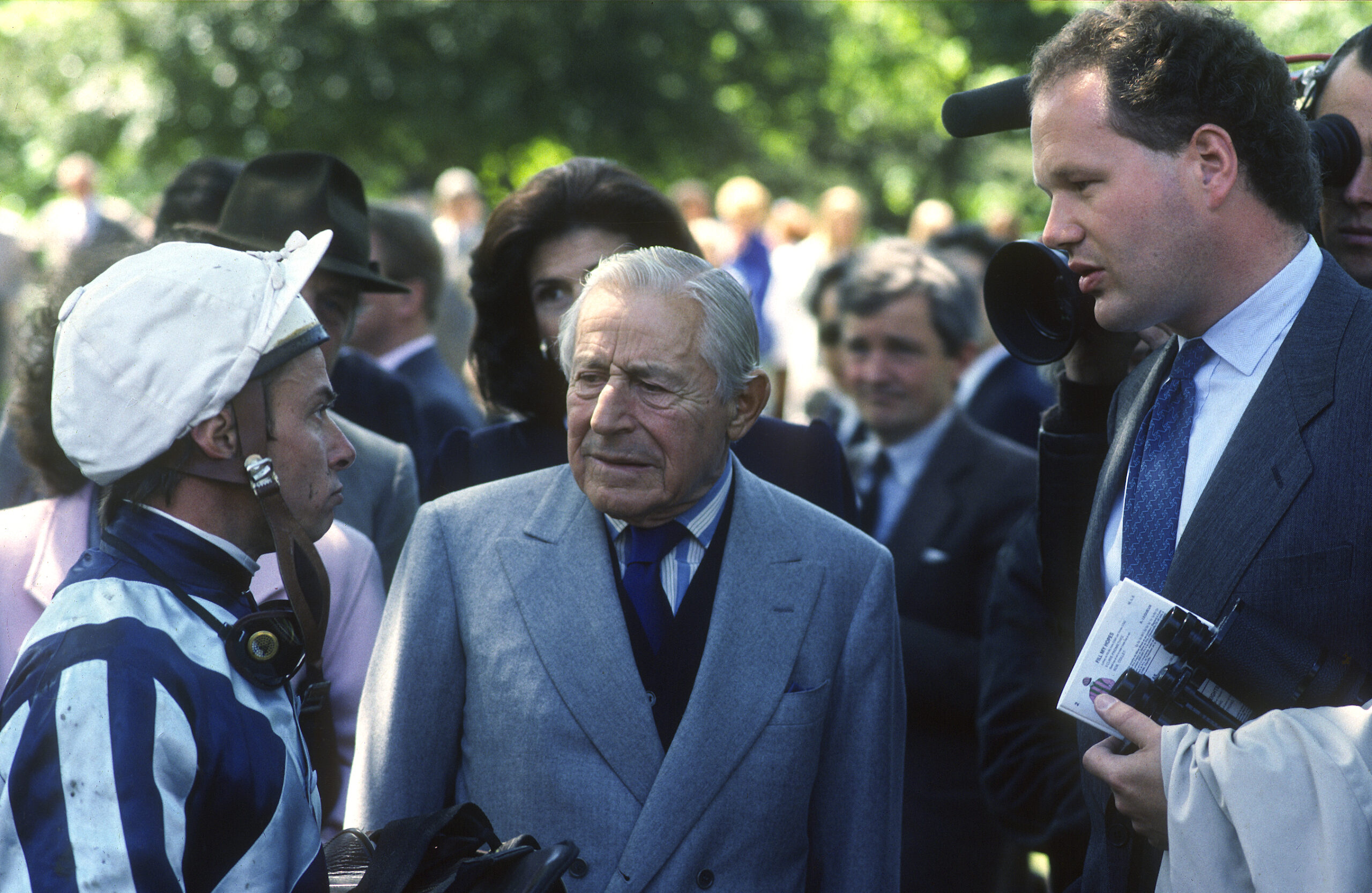
Stavros Niarchos (centre) with Alan Cooper(right) and Freddie Head pictured at Longchamp in 1980. Photo – George Selwyn
Chief among them was the purchase of Nureyev. The Northern Dancer colt was widely expected to be one of the most desirable lots in the 1978 Keeneland July Sale, with the expectation in various quarters that he was a shoe-in to head the way of Robert Sangster and the Coolmore partners, who had forged such an affinity with the sire. But they came up against a determined opponent in Niarchos, who outbid them through the BBA at $1.3 million, the second highest priced figure paid for a yearling at that time. In later years, Niarchos and the Sangster – Coolmore team would join forces, notably in the case of Seattle Dancer, a $13.1 million yearling who won the Gallinule Stakes, and Law Society, the 1985 Irish Derby winner. Phoenix Stakes winner Aviance, who was to become the backbone to a line that provided the Niarchos family with Chimes Of Freedom, Aldebaran and Spinning World, was another raced by the partnership.
As we know, the purchase of Nureyev turned out to be money well spent. He was initially sent to Peter Walwyn in Lambourn but as an unraced summer two-year-old shifted to Francois Boutin, for whom he won Prix Thomas Bryon as a two-year-old and Prix Djebel on his return at three. Yet is for his demotion in the 1980 2,000 Guineas, ‘won’ by a neck over Known Fact, for which he is arguably best remembered. Any chance at redemption was then denied by a virus, which turned out to be career-ending. He went on to become an outstanding sire, firstly at the Niarchos’ Haras du Fresnay-le-Buffard in Normandy and then at Walmac Farm in Kentucky, and with that, an important cog in his owner’s success.
“There was a real transatlantic thinking in crossing bloodlines and building families”
Niarchos continued to make numerous high-profile yearling purchases – and as it turned out, many of them with the capabilities to fulfil a long-lasting legacy.
Coup De Folie, a Halo relation to Northern Dancer, was bought for $825,000. She won the Prix d’Aumale and became the dam of champion two-year-olds Machiavellian and Coup De Genie as well as the ancestress of Arc hero Bago and Prix de Diane winner Senga among many other luminaries. Northern Trick, a $530,000 yearling who won the Prix de Diane, went on to become the ancestress of Light Shift and Ulysses. Salvora, granddam of the Niarchos’ 2015 Grand Prix de Paris winner Erupt, joined the fold as a $725,000 yearling. Lyrism, whose talented daughter Whakilyric foaled Prix du Jockey Club winner and successful sire Hernando, was bought for $350,000.
By contrast, Pasadoble was sourced for just $45,000 as a yearling at Fasig-Tipton in 1980. It was an inexpensive amount for a relation to French champion Comtesse De Loir, especially one who would go on to breed a true champion in Miesque.
“Stavros Niarchos started back in the 1970’s with four mares and one of them, Artists Proof, produced Dactylographer, who won the William Hill Futurity in 1977,” says Cooper. “The breeding operation was being built up at the time so that was an early important success.
“There was a real transatlantic thinking in crossing bloodlines and building families. At that time, there a lot of French horses standing in Kentucky, stallions like Riverman, Lyphard, Caro, Green Dancer. And in our case later on, Kingmambo.
“Francois Boutin had a great understanding of the horse as well as pedigrees. He knew about breeding, training and in particular about raising horses. And then training them and placing them to best effect. He liked that mixture of European and North American bloodlines. Pasadoble might not have been an obvious one to buy. She was a Prove Out filly who cost $45,000. But she was from a good family that had done well in France and she was related to a Grade 1 winner, Silver Supreme, who was a decent sire in Canada.
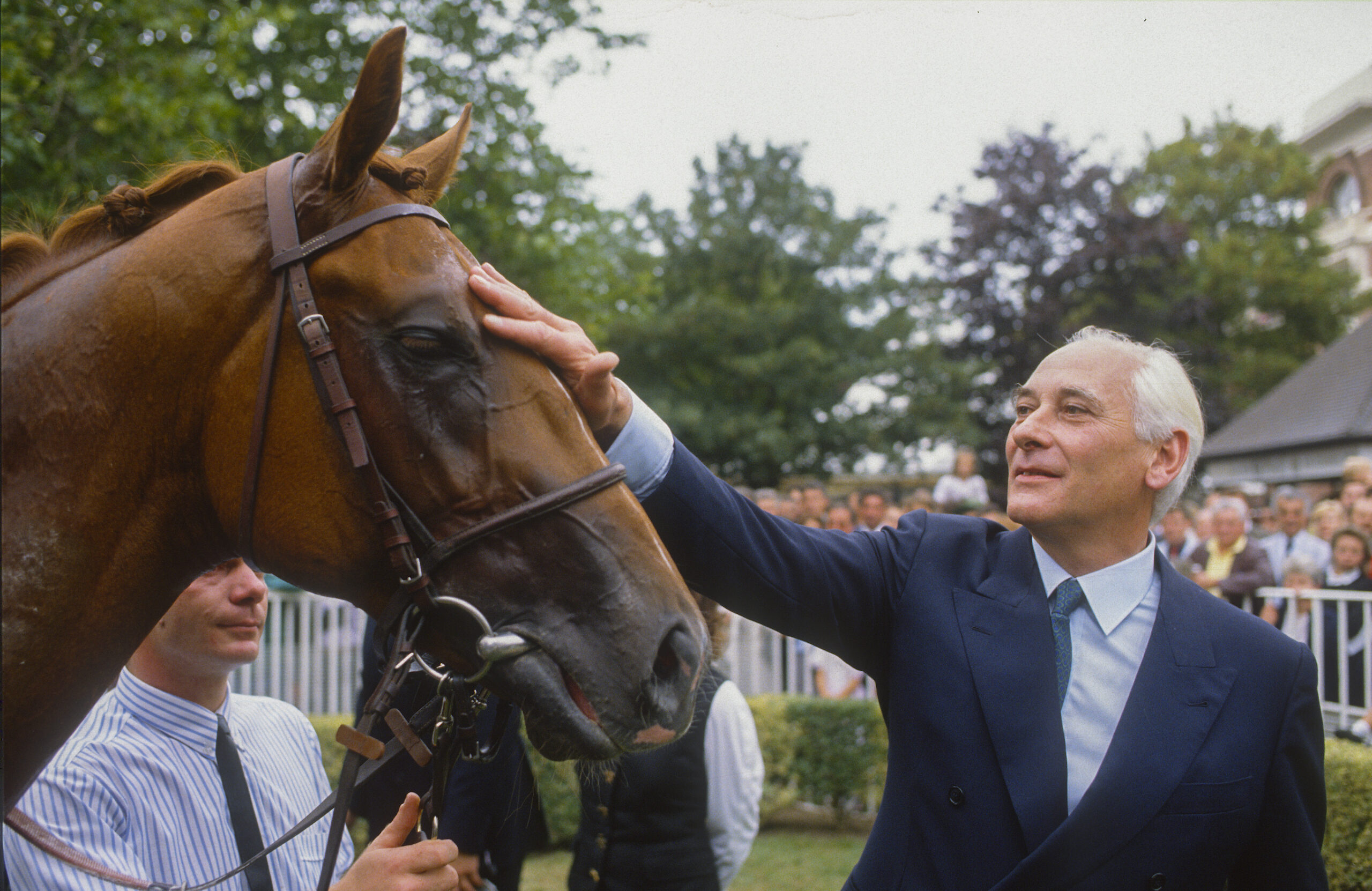
Francois Boutin pictured with Hector Protector following the Prix Morny, Deauville 1990. Photo – George Selwyn
“I remember when Coup De Folie was sold as a yearling, I think my father [Tom Cooper of the BBA Ireland] thought he had a chance to be able to buy her. But Philip had more for her [for Niarchos]. I think she was named Coup De Folie because it was rather a crazy price at the time [her name translates as ‘stroke of folly’]. But what an amazing legacy she left. There’s lot of stallion power running through her family.”
However, not every one of the family’s good broodmares excelled themselves on the track.
“Northern Trick had a daughter by Shirley Heights, Lingerie, who raced numerous times but could not win,” he says. “Francois became very frustrated. He just couldn’t get her to win. But she had enough ability to merit joining the broodmare band and what a legacy she ended up leaving.”
“Maria is very good at thinking outside the box and those Sunday Silence mares that we bred out of that time turned out to be very fruitful”
In what was an interesting move for the era, given the logistics and expense involved, Lingerie was sent to Japan for the 1992 season, where Niarchos’ French champion two-year-old Hector Protector had retired to stud. The Woodman colt swept through a demanding juvenile campaign unbeaten in six starts, three of them at Group 1 level, before landing the Poule d’Essai des Poulains the following year. He found the mile and a half of the Derby beyond him when fourth to Generous but bounced back to win the Prix Jacques le Marois.
“Hector Protector was unbeaten until the Derby, he was an exceptional two-year-old and a very tough, genuine horse,” says Cooper. “He went to stand at the Shadai Stallion Station and was our key to becoming involved with the Yoshida family and the Japanese industry. We sent mares out to Japan to breed to him and switched then to using Sunday Silence and then Deep Impact. Maria is very good at thinking outside the box and those Sunday Silence mares that we bred out of that time turned out to be very fruitful.”
Lingerie’s visits to Hector Protector yielded Prix Foy winner Limnos ahead of the popular Sir Henry Cecil-trained mare Shiva, winner of the 1999 Tattersalls Gold Cup. In later years, the well-travelled Lingerie also foaled the family’s Oaks heroine Light Shift to Kingmambo.
Early usage of Sunday Silence, meanwhile, provided Sun Is Up, a granddaughter of Miesque who later produced Classic-winning miler Karakontie. The same family also later clicked with Sunday Silence’s champion son Deep Impact to produce the Prix du Jockey Club winner Study Of Man.
A key element to the breeding operation has long been the support of various in-house stallions. Nureyev obviously returned the favour as the sire of Miesque in addition to fellow Classic-winning miler Spinning World, whose win in the 1996 Irish 2,000 Guineas came poignantly just weeks after the death of Stavros Niarchos.
In later years, Kingmambo also gifted the family with their outstanding miler Divine Proportions as well as Light Shift. Kingmambo was a brilliant sire but the same cannot be said of the family’s Grade 1-winning miler Aldebaran; the Niarchos-bred Main Sequence, the 2012 Derby runner-up who became a champion turf runner in the US, remains by far the best runner to emerge out of his low-key stud career.
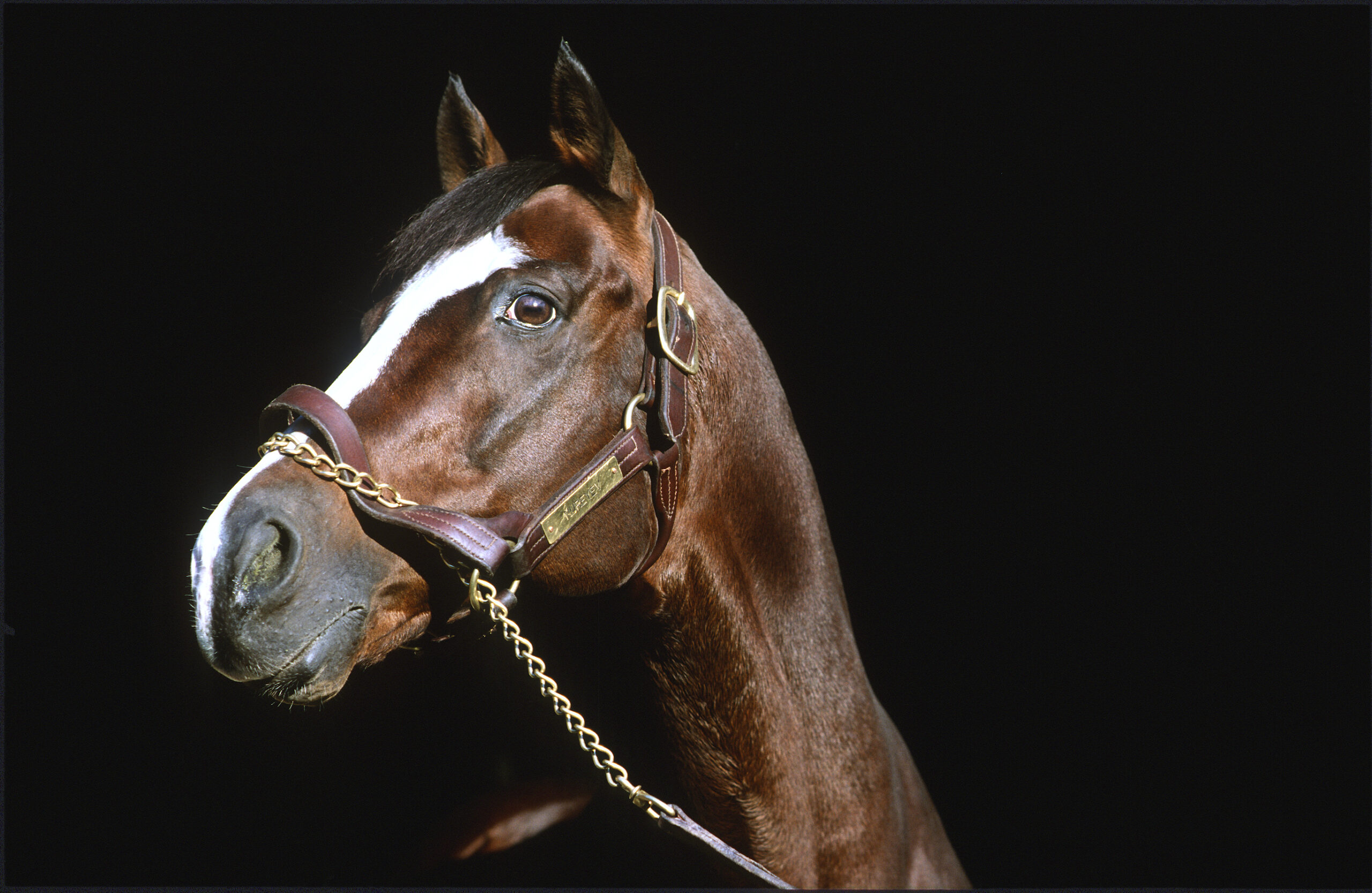
Nureyev: a key cog in the success of the Niarchos family as the sire of Miesque and Spinning World among others. Photo – George Selwyn
Another top-notcher, the 2002 Prix du Jockey Club winner Sulamani, was also one of the most accomplished sired by Hernando. In turn, Sulamani was one of two Jockey Club winners produced for the family out of the Alleged mare Soul Dream alongside Dream Well.
More recently, the family has bred two of the best by Ulysses, Light Shift’s multiple Group 1-winning son who stands at Cheveley Park Stud, in Piz Badile and Passenger. The Poule d’Essai des Poulains and Breeders’ Cup Mile winner Karakontie continues to hold his own at Gainesway Farm in Kentucky, notably as the sire of recent Canadian Group 1 winner She Feels Pretty, while his relation Study Of Man has made an extremely bright start at Lanwades Stud as the sire of Beresford Stakes winner Deepone out his first crop of two-year-olds.
“There’s no getting away from the fact that it is going to be a sad parting. But there will still be over 120 horses still on the books afterwards”
“We have involvement in Ulysses, Study Of Man, Magna Grecia, Circus Maximus and Karakontie,” explains Cooper. “It’s exciting to see Study Of Man do so well. Kirsten [Rausing] has done a wonderful job supporting him. We also have a couple by him in training with Pascal Bary, who trained him.
“It’s that Miesque family again, like Karakontie. He’s also been good to us. He’s knocking on the door – he produces plenty of good winners.
“We will also have a couple of two-year-olds by Circus Maximus in training next year. We’re particularly looking forward to the daughter of Alpha Centauri. She’s just arrived with Jessie Harrington. We have another later developing filly by Circus Maximus out of Freedonia [dam of Albigna] and also a nice, strong colt in partnership with Coolmore who is out of a daughter of Coup De Genie. If they’re good enough, they’ll be able to fly the flag for him.”
The scale of the draft heading to Goffs means that as those Niarchos mares make their way to the ring on November 24, one chapter will come to an end. But as ever, another door will open. A core group of horses will remain split between Europe and the Oak Tree division in Kentucky. Some of those in training will also enter 2024 with Group 1 aspirations.
“Passenger is a horse to look forward to as is Piz Badile,” says Cooper. “There’s no getting away from the fact that it is going to be a sad parting. But there will still be over 120 horses still on the books afterwards. We’ll have about 20 two-year-olds to run next year, the majority fillies, and there are some nice two-year-olds turning three as well. We also have the foals and yearlings to keep the bloodlines going. Hopefully we can produce some more Group 1 winners.”
TO READ MORE ON SOME OF THE BEST HORSES TO HAVE CARRIED THE NIARCHOS COLOURS, CLICK HERE.
FIVE OF THE BEST AT GOFFS
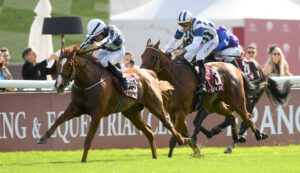
Albigna captures the Prix Marcel Boussac. Photo – Bill Selwyn
ALBIGNA
2017 m Zoffany – Freedonia (Selkirk)
In foal to St Mark’s Basilica
Out of Group 2 winner Freedonia and therefore a member of the family’s Napoli line also responsible for Breeders’ Cup Mile hero Domedriver, Albigna crowned her two-year-old season with Jessica Harrington by taking the Prix Marcel Boussac.
The daughter of Zoffany has a yearling by Wootton Bassett who realised €460,000 to Qatar Racing and the China Horse Club at the Goffs Orby Sale and a filly foal by Dubawi.
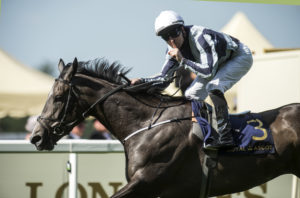
Alpha Centauri was a brilliant miler, just like her relations Miesque and East Of The Moon – Photo: George Selwyn
ALPHA CENTAURI
2015 m Mastercraftsman – Alpha Lupi (Rahy)
In foal to Sea The Stars
Alpha Centauri descends directly from Miesque via French Classic heroine East Of The Moon and emulated those illustrious relatives by becoming an outstanding force over a mile herself. She won the Coronation Stakes at Royal Ascot by six lengths, the Falmouth Stakes at Newmarket by nearly five, the Irish 1,000 Guineas by nearly two and the family-sponsored Prix Jacques le Marois in similarly authoritative fashion over a field of colts and older horses.
Alpha Centauri has a two-year-old Frankel filly named Earth and a yearling filly by Circus Maximus named Proxima Centauri. Both are with Jessica Harrington.
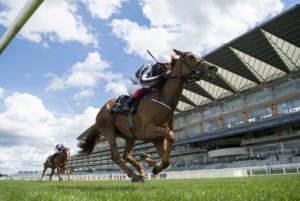
Alpine Star runs out the easy winner of the Coronation Stakes. Photo: Edward Whitaker
ALPINE STAR
2017 m Sea The Moon – Alpha Lupi (Rahy)
In foal to Frankel
Alpha Centauri’s younger half-sister Alpine Star emulated her sibling by capturing the 2020 renewal of the Coronation Stakes at Royal Ascot having won the Debutante Stakes as a two-year-old. She later ran several high-class races in defeat, notably when falling less than a length short of victory in the Prix de Diane, Prix Jacques le Marois and Prix de l’Opera.
Also a half-sister to Moyglare Stud Stakes winner Discoveries, Alpine Star’s first produce is a colt foal by Frankel and she is back in foal to that sire, a mating that produces inbreeding to blue hen Urban Sea.
FONISKA
2020 f Galileo – Bocca Baciata
(Big Bad Bob)
Sold in training
Foniska served notice that she could be a force next season when running out the three-length winner of her most recent start, the Listed Navigation Stakes at Cork, last month.
Also a winner at two, Foniska is out of Group 2 winner Bocca Baciata and hails from a very productive family originally cultivated by Gerry Oldham.
THAT WHICH IS NOT
2013 m Elusive Quality – Shiva (Hector Protector)
In foal to Frankel
A member of the Lingerie family, That Which Is Not was a Listed winner and Group 2-placed in France. Her first foal, Piz Badille, won the Ballysax Stakes en route to running second in the Irish Derby and recently bounced back to winning ways in the Diamond Stakes at Dundalk. Meanwhile, the mare’s second foal, Yosemite Valley, was second to Little Big Bear in last year’s Anglesey Stakes.
That Which Is Not, whose dam Shiva won the 1999 Tattersalls Gold Cup for Sir Henry Cecil, also has a yearling colt by Frankel and foaled a filly by Dubawi this year.
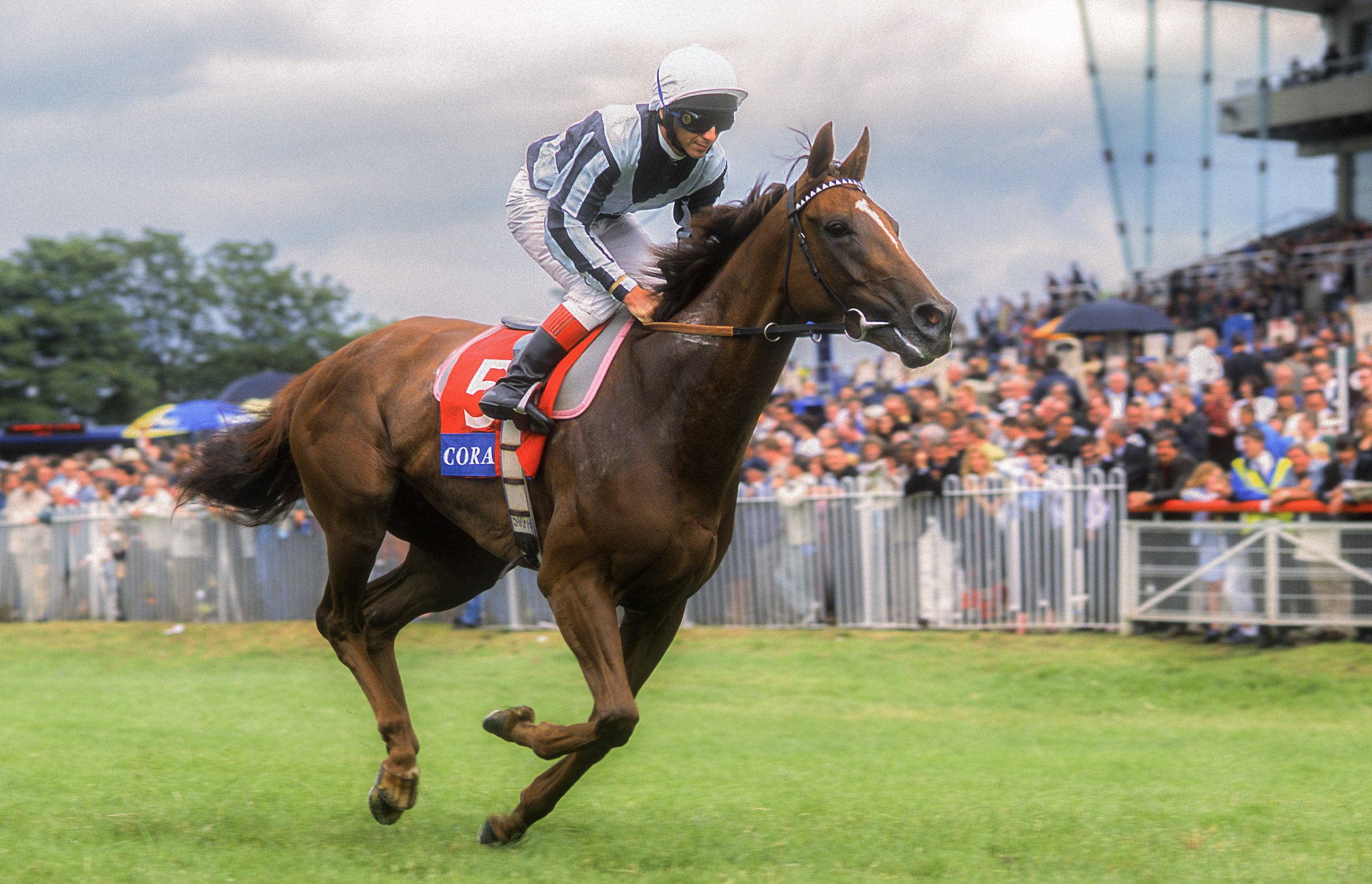
Shiva: top Japanese-bred daughter of Hector Protector is the dam of proven producer That Which Is Not. Photo – George Selwyn


